Your Free Handout
Everyday Trauma
As a counsellor or psychotherapist, you’ll often meet clients who don’t present with “big T” traumatic events, yet carry the weight of experiences that have quietly shaped how they see themselves and relate to others. These are the subtle but significant wounds of everyday trauma – overlooked by society, and sometimes even minimised by clients themselves. Left unrecognised, they can have a lasting impact on wellbeing and the therapeutic relationship. By understanding everyday trauma, you can hold space more effectively and respond with empathy to the hidden struggles clients bring into the room.
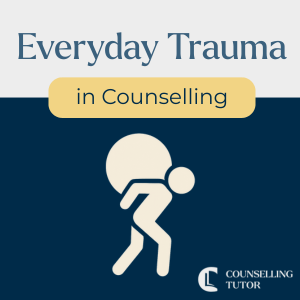
Everyday Trauma
By reading this article, you will:
Ken Kelly: Everyday Trauma.
Rory Lees-Oakes: Yes, everyday trauma. Now it’s the title of a book by Dr. Tracy Shores and she’s an American neuroscientist. And she cites the research that she used to underpin the book, story of a couple who were involved in a serious multiple collision on the freeway. It was a massive crash and they witnessed a very horrific event, suffices to say in the weeks that followed both of the occupants, the man and the woman, both struggled with flashbacks, anxiety, stress, all the things that used to be called post-traumatic stress disorder, but we will refer to as post-traumatic stress. But something remarkable happened as time moved on, the man showed less symptoms of post-traumatic stress, yet his wife was so badly affected by it that she had to sell her business and go into therapy.
And it shows something that isn’t often discussed in the world of trauma and that’s the difference between stress and trauma. So we can have stressful events in our life, which could have a big impact on us, however, they don’t lead to post-traumatic stress. And post-traumatic stress is the inability to cope, that’s the real thing, and I think it’s beautifully summed up by Judith Herman who said, trauma is not defined by the events itself, but by a subjective experience of it.
Everyday trauma can therefore be understood through its impact, not its intensity.
And I think that’s really important for therapists to understand, because traditionally we’ve always thought of post-traumatic stress as massive events that happened such as abuse, childhood experiences. Facts of the matter is, they can be a cumulative response to someone going through just a very bad period of their life, Ken.
Ken Kelly: Yeah, we’re seeing trauma present all the time. And I guess if we look in our own lives, and a great place to start is with that personal development.
And I wanted to dig straight into education based trauma because I experienced it myself, I’m dyslexic, neurodivergent. It wasn’t understood when I was at school.I was labeled lazy, I wasn’t trying hard enough.At the time it just felt stressful, and I didn’t like school, and I had an adversity to that. But now looking back, I notice that I have trauma responses to that and it affects me as an adult.
And an example of that would be, going for a job interview where you might be asked to fill out a form before going in. When they give me that form, because of my dyslexia, I have a trauma response where I start sweating. I start shaking. And I have an inability to present myself in a calm and measured way.
That’s educational based trauma.
And the impact of that is shame, fear, low self-esteem, social anxiety.
Yeah, absolutely, Ken.
Rory Lees-Oakes: The other thing is, things like emotionally unavailable, inconsistent, or critical caregivers, parents, other people who care for us that can impact on us and our ability to cope, as can something called triangulation within families.
You may get, two children in a family. One is treated very well and is the golden child and the other isn’t. And what I’m trying to get across here is the cumulative effects. It’s not just one event, it’s a cumulative effects of low level, not a massive event.
And certainly things like in workplaces such as, toxic environments, job insecurity, unfair dismissal, all these things lead to everyday trauma. And the thing is, Ken, sometimes it can slide past us as therapists.
So a client talks about this, because we may still have in our mind trauma with the big T, it slides past us and we don’t exercise the same amount of curiosity, or engage with it as we would if it was trauma with a big T.
Ken Kelly: Very much, and it’s as impactful as the trauma with the big T, Rory.
So we’ve covered kind of the relational and attachment trauma within the family and the early development years, we’ve looked at education based trauma, you’ve just touched on workplace and institutional trauma.
Now you can definitely gain trauma from workplace bullying all of that, and the impact of that is burnout, depression, imposter syndrome. So this is what we might be seeing as counsellors. Somebody coming in and saying, oh, I’m burnt out in my job, imposter syndrome. So it’s common presentations, and there can be underlying trauma, and this is why we’re having this discussion.
At Counselling Tutor we train trauma informed practice, how to work with trauma, you can get all the information of our courses. Just go to counsellingtutor.com, click on our products tab, it’s all there. But it’s important to be able to first identify, and then be able to recognise that there may be a trauma base to this.
And then the next step is being able to work with that with the client. And it’s tricky work, with all the personal development I’ve done, I still have my trauma responses that are deep inside me. It’s very primitive brain, those trauma reactions. You’re taken back to a time that is not now. There is, of course, medical and health related trauma, and I think many might be able to relate to that either with themselves or within their families.
That can lead to hypervigilance, health anxiety, mistrust of authorities, like you can’t trust the doctors, the hospital, whatever that may be. Something, I’m sure again, so many can relate to, is trauma from poverty and housing instability, food instability, living in an unsafe neighbourhood. These are what we can view as maybe a stressful situation, but they can lead to trauma and that trauma being present in someone, maybe it was three years ago and they’re now in a different part of their life, but they still have the fears around that.
It’s a chronic stress, survival based coping strategies, even when it’s not warranted.
it’s a very interesting topic, everyday discrimination as a happily and proudly neurodivergent autistic person, I relate back to trauma that comes from not being recognised, my way of thinking and learning not being seen. And really it’s discrimination and oppression over years and years, decades and decades, of my life.
A weighty topic, Rory.
Rory Lees-Oakes: It is. And of course we’ve not even covered ongoing experiences of racism, sexism, homophobia, transphobia, ableism, or having to hide your identity, masking neurodivergence is something that I think a lot of us who are neurodivergent do.
And that creates a lot of stress. And I think it’s really useful at this point to pause and say that one of the things that would impact a trauma response is the fact that events can rewire our brains.
And we know the research is really clear now, our brains can rewire, mainly for survival, so that we get a stress response to tell us to keep out of situations. It’s very primitive, as Ken said.
Things like not wanting to go into the office, not wanting to go into a crowd of people, those are things that can really hold you back. And I think why it matters in the therapist room is that clients may struggle to recognise these experiences as a trauma.
You might downplay them. And I think one of the key things we could do as therapists is hold the space, really tune in empathically, and listen to the stories or the narratives that may have been minimised elsewhere. You internalise them.
Ken Kelly: Yeah, and we end up labelling ourselves. I’m not very academic, that was the label I carried for a while because it was somebody else’s values or the treatment of me from the past that made me develop that self concept. And you mentioned, maybe a client would not see it as linking to trauma, and I guess that’s not a client’s job. We as therapists need to understand it. We’ve gotta make that connection to be able to work with that person fully and in the correct way.
Hold the space, be kind and empathic, and listen. And secondly, use curiosity, not correction with your client when they’re presenting. And you may hear a client diminishing or dismissing it, and putting it to one side, when it is still very real with that person. And if we are working with curiosity, we can explore that deeper.
If we do have a client who maybe dismisses their suffering or pushes that to one side, we can recognise it for what it really is and reframe it in the moment, and be there empathically for that person.
So when it is brought in our sessions, just being curious, surrounding them with that love of a different kind for what they have gone through, is a good path for working with everyday trauma. Rory?
Rory Lees-Oakes: Yeah, absolutely. And I will go back to that original quote by Judith Herman, who I quote in the Trauma Informed Practice course, she said trauma isn’t defined by the event itself. So people could go through horrendous events and not have any trauma symptoms at all. But it’s a subjective experience of it.
So what we are looking for is the impact, not the story.
So when people are talking about what’s going on for them, it’s not actually the story, it’s the emotion that’s conveyed in that story that can give us a clue
One of the things we know where people have a trauma response is there’s a visceral feeling in the body. I’ve worked with clients where they’ve been talking about a situation and their feet have been running, they’ve been sat at the chair, but their legs have been in a running mode.
So it is very important that we don’t adopt a non pathologising stance. In other words, we don’t diagnose, we don’t come across as experts, we just work with the client. Work with what they’ve got, and give them the space. We give them the space for them to speak about what’s going on without the usual dismissals or minimisation they may get when they’re talking to their friends or their families or at work.
Not all trauma stems from catastrophic or life-threatening events. In therapy, many clients present with the lasting effects of experiences that may not meet the diagnostic threshold for post-traumatic stress disorder (PTSD), yet still shape their mental health and wellbeing in deep ways.
Everyday trauma describes those ongoing, cumulative experiences that overwhelm a person’s capacity to cope. Clients may not always recognise these experiences as traumatic, often framing them as ‘just part of life’.
Trauma is defined not by the event itself, but by the person’s subjective experience of it.
Everyday trauma is therefore best understood through its impact, not its intensity.
It’s important for counsellors to remember that clients may describe events as “stressful” rather than “traumatic.” What distinguishes trauma is not the scale of the event, but whether it leaves the client unable to cope, often re-experiencing or carrying the effects long after the event has passed.
In practice, a client may not label these as trauma. They might instead describe struggling with closeness in relationships, or carrying a persistent sense of “not being good enough.”
A neurodivergent client who was misunderstood at school might recall being labelled as lazy or not trying hard enough. As an adult, this could resurface in settings like job interviews, where even filling out a form may trigger anxiety and physical stress responses.
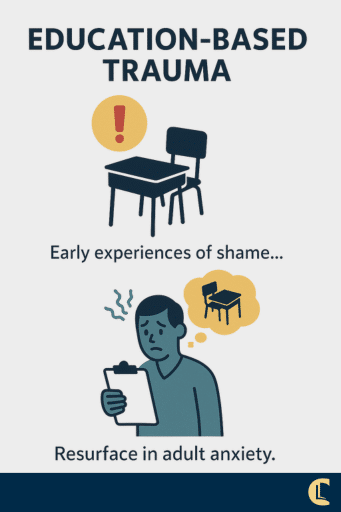
Clients often present describing “burnout” or “imposter syndrome.” While these can be understood on the surface as workplace issues, they may also have roots in unresolved trauma responses linked to persistent stress or bullying in professional settings.
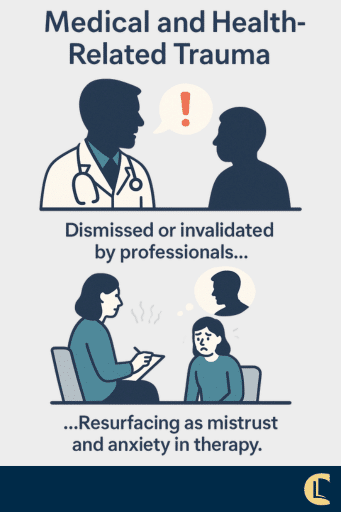
Some clients who have repeatedly felt ignored or invalidated by medical professionals may carry a lasting mistrust of authority. In therapy, this can show up as heightened vigilance or difficulty trusting the therapeutic process itself.
Even when life circumstances improve, clients may describe always feeling “on edge” or unable to relax. Past experiences of poverty or instability can create long-lasting survival-based coping patterns, such as hyper-awareness of financial risks or a tendency to expect instability.
Clients who have had to hide parts of their identity – for instance, masking neurodivergence – may carry exhaustion and self-doubt. Others may downplay the impact of daily discrimination, not recognising it as trauma, even while it has rewired their stress responses over time.
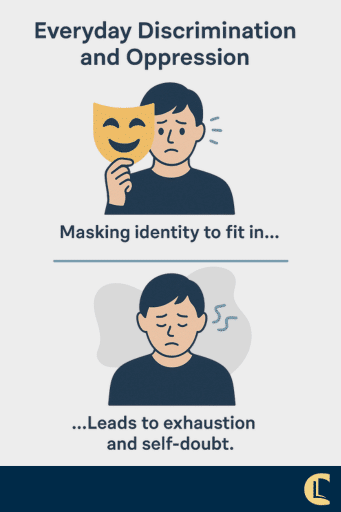
Clients may describe these experiences as “something I should be over by now,” minimising the pain because society doesn’t always validate such losses. Yet in the therapy room, the depth of grief may become clear.
Because everyday trauma is often quiet and cumulative, it can slip past unnoticed if we are only looking for “big T” events. Clients may present with symptoms – anxiety, burnout, low self-esteem – without linking them to trauma.
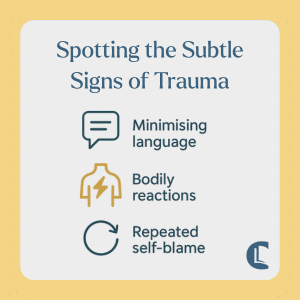
As counsellors, our role is to:
By noticing subtle cues – a client’s minimising language, a visceral bodily reaction, or repeated patterns of self-blame – we can recognise trauma that might otherwise remain hidden.
These considerations encourage counsellors to build trust, strengthen the therapeutic alliance, and create a space where clients feel safe enough to explore what they may have long minimised.
Everyday Trauma
Stress can be a natural response to challenging events, and often resolves once the situation passes. Everyday trauma, however, leaves a deeper mark. It overwhelms a person’s ability to cope, and its impact can continue long after the event itself. For counsellors, the key is to look beyond the story and notice the ongoing emotional or bodily responses that suggest trauma.
Everyday trauma is often hidden in plain sight. Clients may downplay their suffering with phrases like, “It wasn’t that bad.” Others may present with symptoms such as burnout, imposter syndrome, or low self-esteem without recognising these as linked to past trauma. Counsellors might also notice somatic responses in session – shaking, sweating, or agitation – which signal that the body is holding the memory of past experiences.
When clients dismiss or downplay their experiences, curiosity is more helpful than correction. Counsellors can gently explore what lies beneath the minimising language, validate the impact of cumulative stressors, and adopt a non-pathologising stance. Recognising coping strategies as adaptive rather than dysfunctional helps build trust and creates a safe space for clients to reflect more deeply.
Everyday trauma is often persistent and overlooked. Yet for many clients, it has shaped their identity, relationships, and resilience in lasting and meaningful ways.
By recognising and responding to these subtle but significant experiences, counsellors can strengthen the therapeutic alliance and encourage clients to reframe their stories – not as “not bad enough,” but as worthy of care, attention, and healing.
Herman, J. L. (1992). Trauma and Recovery. New York: Basic Books.
SAMHSA (2014). Trauma-Informed Care in Behavioral Health Services.
Schore, A. N. (2003). Affect Dysregulation and Disorders of the Self. New York: W. W. Norton.
Sue, D. W. et al. (2007). Racial microaggressions in everyday life: Implications for clinical practice. American Psychologist, 62(4), 271–286.
Van der Kolk, B. (2014). The Body Keeps the Score. New York: Penguin.
Counselling Tutor provides trusted resources for counselling students and qualified practitioners. Our expert-led articles, study guides, and CPD resources are designed to support your growth, confidence, and professional development.
👉 Meet the team behind Counselling Tutor
Notice any broken link or issues with this resource? Kindly let us know by email
Email us